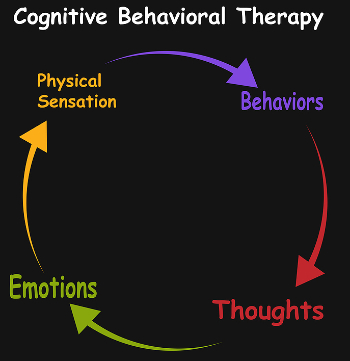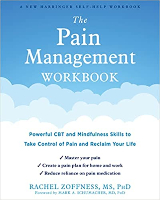How You Think Affects Your Pain
Mar 09, 2022
Listen to the audio version of this blog Here.
Thoughts are inputs into the nervous system that can increase or decrease your sensation of pain.
Have you ever noticed your pain decrease when you are having fun, in a beautiful place, or engaged in a meaningful activity?
Conversely, have you felt your pain increase when you receive an overdue bill in the mail, argue with your coworker, or watch the news?
Thoughts that make you feel good decrease pain, while thoughts that upset you increase pain. This is because positive thoughts activate your parasympathetic nervous system (PNS) relaxation response. And, negative thoughts activate your sympathetic nervous system (SNS) stress response (fight, flight, freeze). For a refresher on the PNS and SNS, refer to the related blogs listed below.
Related Blogs
Overcome Stress by Invoking the Relaxation Response
Book Review: Why Zebra’s Don’t Get Ulcers
The Cycle of Thoughts - Emotions - Behaviors
 Cognitive Behavioral Therapy (CBT) is often used to treat chronic pain. CBT has techniques to change thought patterns that can reduce stress and the resultant pain sensation. Before I get to the techniques, however, you need to understand where negative thoughts lead. Look at the CBT model to the right. It shows how our thoughts cycle with emotions, sensations (often pain), and behaviors. The cycle is generally kicked off by an event of some sort. However, it’s usually
Cognitive Behavioral Therapy (CBT) is often used to treat chronic pain. CBT has techniques to change thought patterns that can reduce stress and the resultant pain sensation. Before I get to the techniques, however, you need to understand where negative thoughts lead. Look at the CBT model to the right. It shows how our thoughts cycle with emotions, sensations (often pain), and behaviors. The cycle is generally kicked off by an event of some sort. However, it’s usually
kicked off by a negative event, one that may or may not be related to your body. For example, an event could be a pain flare-up, but it could just as easily be bad news or a sleepless night. Then the cycle ensues as follows:
Step 1: You have thoughts about the event. Usually, these thoughts are so familiar that they become automatic. For example, “I didn’t sleep and won’t get anything done today.”
Step 2: You feel emotions in response to this thought. For example, you feel defeated and hopeless.
Step 3: These emotions are then felt as sensations in your body. For example, your body feels heavier than normal, and it is hard for you to move, or you have an ache in your back.
Step 4: These emotions then lead to behaviors. For example, you close the blinds, keep the lights off, stay in your pajamas, and lie on the couch watching Netflix all day.
Step 5: Your behaviors reinforce your thoughts and emotions. For example, staying in the dark, not getting dressed for the day and lying around sends the message to your brain that you are not well. And around and around you go, staying stuck in the loop–all because of a negative thought in response to an event.
An important thing to realize here is that our thoughts are separate from the actual events. Our brains create a perception about, and attach meaning to, the things that happen to us. Our thoughts are not what happened to us; instead, they are what we perceive about what happened to us. In other words, thoughts are the story we create about the experience.
If we are in a clear mental state, the emotional response and behaviors will be “normal.” However, according to David Burns, MD, a renowned psychiatrist, award-winning researcher, and author of Feeling Good, there is often “mental ‘static’ - distortions” in our perceptions--especially if we are in a depressed state, which often accompanies chronic pain. These distortions affect our thinking and all that flows around the CBT cycle from there.
Distorted Thinking Patterns
 Just as our bodies have habitual postures and movement patterns, so, too, do our minds. We tend to repeatedly have the same thoughts and can fall into faulty thought patterns. In CBT these inaccurate thought patterns, or traps, are referred to as “cognitive distortions.” Below are the 10 cognitive distortions from David Burn’s book, Feeling Good. Notice if you recognize any distorted thought patterns in your inner monologue and write them down. You will be using these for the next exercise.
Just as our bodies have habitual postures and movement patterns, so, too, do our minds. We tend to repeatedly have the same thoughts and can fall into faulty thought patterns. In CBT these inaccurate thought patterns, or traps, are referred to as “cognitive distortions.” Below are the 10 cognitive distortions from David Burn’s book, Feeling Good. Notice if you recognize any distorted thought patterns in your inner monologue and write them down. You will be using these for the next exercise.
All-or-Nothing Thinking: Evaluating everything in an extreme manner, including your personal qualities. This type of thinking is black or white, right or wrong, good or bad, etc.
Example: After trying a new therapy to alleviate your pain, you think, “This therapy didn’t help, so no therapy will help. I am hopeless.”
Overgeneralization: Concluding that one negative event will repeat over and over.
Example: You have pain one day after walking up a steep hill and think, “I will never be able to walk up a hill without pain.”
Mental Filter: Not seeing the positive and fixating on the negative. This is also known as the negativity bias. We dwell and hold onto the negative and easily overlook and let go of the positive.
Example: You have pain on the last 100 meters of your half mile swim and think, “Swimming hurts.” Yes, the last 100 meters hurt; however, much of your swim was pain free. Unfortunately, all you can remember is the pain at the end.
Disqualifying the Positive: Transforming neutral or positive experiences into negative ones.
Example: Your therapist gives you a compliment on how you are improving on an exercise, and you think or say, “But the contraction is still so weak, and I still can’t do [fill in your exercise or activity of choice].”
Jumping to Conclusions: Drawing negative conclusions that are not based on facts. There are two types of this thinking pattern: mind reading and the fortune teller error.
Mind Reading: You assume others are looking down on you or judging you negatively.
Example: You must use a scooter in the grocery store after a hip procedure. You think, “People must be rolling their eyes at me using this thing when I look perfectly healthy.”
Fortune Teller Error: You predict and believe the worst for your future despite your imagination being unrealistic.
Example: You have back pain in your 50’s and tell yourself, “My back is falling apart and will never get any better. I’ll be in a wheelchair by the time I’m 55.”
Magnification and Minimization: Enlarging the negative (catastrophizing) and shrinking the positive.
My Example: I felt pain in my left hip after three left knee surgeries. I thought, “OMG, not another joint gone bad! I’m going to need another surgery. How can this be happening to me? My whole body is falling apart. I’m never going to ride again.” Probably a few thought distortions in there. ;-)
Emotional Reasoning: You base your thoughts on your emotions. In other words, your feelings drive your thoughts.
Example: You feel sad and think, “There must be something terribly wrong with me.”
Should Statements: Using “should” or “must” statements about yourself or others.
Example: You have been doing posture exercises for two weeks and think, “My pain should be gone by now.” “Should” and “must'' statements create pressure and resentment.
Labeling and Mislabeling: Creating a negative personal label.
Example: You come in second in a race and think, “I’m a loser.”
Personalization: You assume responsibility for the negative things that happen, even when it is clearly not your fault.
Example: The surgery did not take away your pain and you think, “I must have done something wrong in my recovery.” Personalization creates excessive guilt from this burden of responsibility.
How to Change Your Thoughts
 Now it’s time to act! Rachel Zoffness, MS, PhD, a pain psychologist, medical consultant, and author of The Pain Management Workbook, provides several CBT exercises in her book to work with negative thoughts. Below is an abbreviated exercise that I modified from her workbook.
Now it’s time to act! Rachel Zoffness, MS, PhD, a pain psychologist, medical consultant, and author of The Pain Management Workbook, provides several CBT exercises in her book to work with negative thoughts. Below is an abbreviated exercise that I modified from her workbook.
Step 1: Look at your list of cognitive distortions. Then, pick one to work with.
Step 2: How does this thought make you feel (emotion)?
Step 3: Ask yourself: is this absolutely, positively, without a doubt true? If this seems familiar, you are right! It’s the first step in Byron Katie’s process called “The Works.” Learn more in this blog: Transforming Your Limiting Beliefs.
Step 4: Do you have any evidence that this thought is NOT true? That is, are there any circumstances or situations, no matter how small or infrequent, in which your thought has been proven wrong?
Step 5: Is the opposite of what you are predicting just as likely to happen?
Step 6: Given the choice between your original thought (Step 1) and the opposite thought (Step 5), which thought do you choose to believe?
Step 7: How does this thought make you feel (emotion)?
My Example:
- Cognitive Distortion (fortune telling): I am going to need a hip replacement.
- How does this thought make me feel? Scared, vulnerable, cautious.
- Is this for sure true? No.
- Contrary Evidence: I was diagnosed with severe hip osteoarthritis over a decade ago and my pain is less now. I can do more now. Technology has advanced and there are other less invasive treatments I can try before a hip replacement . . .
- Is the opposite--not having a hip replacement--just as likely? Yes!
- Which thought do I choose to believe: that I’ll need a hip replacement or that I won’t? I choose that I won’t need a hip replacement.
- How does this thought make me feel? Lighter, free, expansive.
Summary
Thoughts are inputs into the nervous system that can increase or decrease your sensation of pain. Positive thoughts activate your parasympathetic nervous system and reduce pain. Negative thoughts activate your sympathetic nervous system and increase pain. Your thoughts impact and cycle through with your emotions, sensations, and behaviors. This cycle starts with an event that is separate from the thought. Perceptions of the event are created in the brain which can be distorted, leading to unclear thinking about what has happened. This process is often automatic and unconscious. CBT offers techniques to examine and change these faulty thinking patterns.
What to learn more? Contact me to schedule a free consultation to learn how I can help you with the mind game of pain and injury.
Stay connected with news and updates!
Join our mailing list to receive the latest news and updates from me.
Don't worry, your information will not be shared.
We hate SPAM. We will never sell your information, for any reason.

